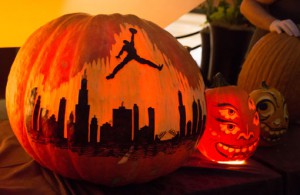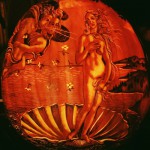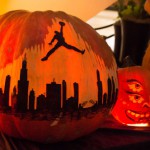By Ashley Altus
After carving away layers of pumpkin to create jack-o’-lantern sculptures, Edward Cabral’s pumpkin masterpieces can’t be preserved. And that’s how he likes it.
“Anything you make as an artist, whether it be a painting or a pumpkin, it’s going to turn to dust eventually – in the grand scheme of time,” Cabral said. “To make something and to assume that’s its permanent is kind of silly. I just love to speed up that process.”
On Wednesday, Cabral carved Michael Jordan jumping over the skyline of Chicago into a 100 pound pumpkin at the Intercontinental Chicago Magnificent Mile hotel. He worked at the perfect place – just outside of Michael Jordan’s Steakhouse Chicago, a popular hot spot in the hotel. Hotel guests looked on in awe to watch as he sculpted several pumpkins throughout the day.

Cabral got started in pumpkin carving when he moved to Louisville on a whim after graduating from the School of the Art Institute of Chicago. For the past three years he has been working at the Jack-O-Lantern Spectacular Louisville, an art show held in the woods with 100 intricately carved pumpkins as well as 5,000 illuminated pumpkins.
Even though he has moved back to Chicago, he still travels to Louisville for two months every year to work 18 hour days carving everything from pumpkin faces to pumpkin-memorialized moments in history – like the first moon landing. Cabral said his “real-person job” when it’s not pumpkin season is working as a cake sculptor for catering companies and other clients.
He said he is fascinated by art that can’t be archived and it allows him to improve his form.
“I can focus more on my technique and my craftsmanship as opposed to going back and fretting over something I made 3 years,” Cabral said.
To start his process, Cabral first washes down his pumpkins with rubbing alcohol to remove wax before sketching out his concept with markers on the surface. He uses dry wall and wood carving tools to carefully scrap away layers of the pumpkin to add depth and texture. Cabral’s last step is hollowing out the pumpkin from the bottom to create a sturdy base while leaving the top in natural form.
After all the hours of work, Cabral’s pumpkin sculptors begin to decay in about four to seven days.
“It’s the nature of the beast, before you even gut it you have to realize this is going to be an impermanent thing, It’s going to rot away.” Cabral said.
One day he said he would love to bring to Chicago a franchise of the pumpkin show he carves for in Louisville.





